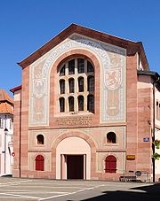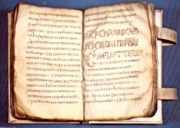
Humanist Library of Sélestat
Encyclopedia
The Humanist Library in Sélestat
is one of the most important cultural treasures of Alsace
, France
. According to a traditional saying, Alsace has three great treasures: Strasbourg Cathedral
, the Isenheim Altarpiece
in Colmar
and the Humanist Library in Sélestat.
Actually, there are in fact two Renaissance humanist libraries involved, the library of the Humanist School and the private library of the famous scholar, Beatus Rhenanus
(1485-1547).

 In 1441, the municipal authorities of Sélestat appointed Ludwig Dringenberg
In 1441, the municipal authorities of Sélestat appointed Ludwig Dringenberg
, born in Westphalia, to be the leader of the local Latin school
. The appointment proved to be a stroke of luck. Dringenberg turned out to be a gifted and committed educator, who had an open attitude toward intellectual trends of the time. Under his leadership emerged the first school on the Upper Rhine
where Humanist thinking was fostered. His successors, Kraft Hofman (1477-1501), Hieronymus Gebwiler (1501-1509) and Hans Sapidus (1510-1525), knew how to increase the reputation of the school still further. Thus, the school was the training place of an entire generation of Alsatian Humanists. The school also had a library which steadily grew in extent through endowments and gifts (from Jakob Wimpfeling
of Sélestat, among others).
bequeathed his entire private library to his home city of Sélestat. This library contained about 670 bound leather volumes at the time of this death in 1547, which Rhenanus had collected during his studies and his work in Strasbourg
, Basel
, Paris
and Sélestat. Even at that time, the library was of inestimable value, since books were only published in small numbers of copies and they were extremely expensive. The library of Beatus Rhenanus is the only larger Humanist library preserved virtually intact. Other large libraries, such as those of Erasmus von Rotterdam or Johannes Reuchlin, were scattered after the deaths of their owners.
The Library of Beatus Rhenanus was inscribed in the UNESCO
's Memory of the World
Register in 2011.
, 460 ancient and modern manuscript
s, 2,200 16th century prints, 1,600 17th century prints and 2,600 18th century prints. The rooms also display a collection of 15th and 16th century Upper-Rhenish religious paintings and sculpture.
Sélestat
Sélestat is a commune in the Bas-Rhin department in Alsace in north-eastern France.In 2006, Sélestat had a total population of 19,459. The Communauté de communes de Sélestat et environs had a total population of 35,397.-Geography:...
is one of the most important cultural treasures of Alsace
Alsace
Alsace is the fifth-smallest of the 27 regions of France in land area , and the smallest in metropolitan France. It is also the seventh-most densely populated region in France and third most densely populated region in metropolitan France, with ca. 220 inhabitants per km²...
, France
France
The French Republic , The French Republic , The French Republic , (commonly known as France , is a unitary semi-presidential republic in Western Europe with several overseas territories and islands located on other continents and in the Indian, Pacific, and Atlantic oceans. Metropolitan France...
. According to a traditional saying, Alsace has three great treasures: Strasbourg Cathedral
Strasbourg Cathedral
Strasbourg Cathedral or the Cathedral of Our Lady of Strasbourg is a Roman Catholic cathedral in Strasbourg, France. Although considerable parts of it are still in Romanesque architecture, it is widely consideredSusan Bernstein: , The Johns Hopkins University Press to be among the finest...
, the Isenheim Altarpiece
Isenheim Altarpiece
The Isenheim Altarpiece is an altarpiece painted by the German artist Matthias Grünewald in 1506-1515. It is on display at the Unterlinden Museum at Colmar, Alsace, now in France....
in Colmar
Colmar
Colmar is a commune in the Haut-Rhin department in Alsace in north-eastern France.It is the capital of the department. Colmar is also the seat of the highest jurisdiction in Alsace, the appellate court....
and the Humanist Library in Sélestat.
Actually, there are in fact two Renaissance humanist libraries involved, the library of the Humanist School and the private library of the famous scholar, Beatus Rhenanus
Beatus Rhenanus
Beatus Rhenanus , also known as Beatus Bild, was an Alsatian humanist, religious reformer, and classical scholar....
(1485-1547).
The Library of the Humanist School


Ludwig Dringenberg
Ludwig Dringenberg , was a German monk, educator and humanist....
, born in Westphalia, to be the leader of the local Latin school
Latin School
Latin School may refer to:* Latin schools of Medieval Europe* These schools in the United States:** Boston Latin School, Boston, MA** Brooklyn Latin School, New York, NY** Brother Joseph C. Fox Latin School, Long Island, NY...
. The appointment proved to be a stroke of luck. Dringenberg turned out to be a gifted and committed educator, who had an open attitude toward intellectual trends of the time. Under his leadership emerged the first school on the Upper Rhine
Upper Rhine
The Upper Rhine is the section of the Rhine in the Upper Rhine Plain between Basel, Switzerland and Bingen, Germany. The river is marked by Rhine-kilometers 170 to 529 ....
where Humanist thinking was fostered. His successors, Kraft Hofman (1477-1501), Hieronymus Gebwiler (1501-1509) and Hans Sapidus (1510-1525), knew how to increase the reputation of the school still further. Thus, the school was the training place of an entire generation of Alsatian Humanists. The school also had a library which steadily grew in extent through endowments and gifts (from Jakob Wimpfeling
Jakob Wimpfeling
Jakob Wimpfeling was a Renaissance humanist and theologian.- Biography :Wimpfeling was born in Sélestat, Alsace. He went to the school at Sélestat, which was run by Ludwig Dringenberg, the founder of the Humanist Library of Sélestat...
of Sélestat, among others).
The Library of Beatus Rhenanus
Beatus RhenanusBeatus Rhenanus
Beatus Rhenanus , also known as Beatus Bild, was an Alsatian humanist, religious reformer, and classical scholar....
bequeathed his entire private library to his home city of Sélestat. This library contained about 670 bound leather volumes at the time of this death in 1547, which Rhenanus had collected during his studies and his work in Strasbourg
Strasbourg
Strasbourg is the capital and principal city of the Alsace region in eastern France and is the official seat of the European Parliament. Located close to the border with Germany, it is the capital of the Bas-Rhin département. The city and the region of Alsace are historically German-speaking,...
, Basel
Basel
Basel or Basle In the national languages of Switzerland the city is also known as Bâle , Basilea and Basilea is Switzerland's third most populous city with about 166,000 inhabitants. Located where the Swiss, French and German borders meet, Basel also has suburbs in France and Germany...
, Paris
Sorbonne
The Sorbonne is an edifice of the Latin Quarter, in Paris, France, which has been the historical house of the former University of Paris...
and Sélestat. Even at that time, the library was of inestimable value, since books were only published in small numbers of copies and they were extremely expensive. The library of Beatus Rhenanus is the only larger Humanist library preserved virtually intact. Other large libraries, such as those of Erasmus von Rotterdam or Johannes Reuchlin, were scattered after the deaths of their owners.
The Library of Beatus Rhenanus was inscribed in the UNESCO
UNESCO
The United Nations Educational, Scientific and Cultural Organization is a specialized agency of the United Nations...
's Memory of the World
Memory of the World Programme
UNESCO's Memory of the World Programme is an international initiative launched to safeguard the documentary heritage of humanity against collective amnesia, neglect, the ravages of time and climatic conditions, and willful and deliberate destruction...
Register in 2011.
The Humanists of Sélestat
The Alsatian Humanists closely associated with the expansion of the library include:- Jakob WimpfelingJakob WimpfelingJakob Wimpfeling was a Renaissance humanist and theologian.- Biography :Wimpfeling was born in Sélestat, Alsace. He went to the school at Sélestat, which was run by Ludwig Dringenberg, the founder of the Humanist Library of Sélestat...
(1450-1528), theologian, historian and educator - Martin ButzerMartin BucerMartin Bucer was a Protestant reformer based in Strasbourg who influenced Lutheran, Calvinist, and Anglican doctrines and practices. Bucer was originally a member of the Dominican Order, but after meeting and being influenced by Martin Luther in 1518 he arranged for his monastic vows to be annulled...
(1491-1551), theologian, the "Alsatian Reformer" - Jakob Spiegel (1483-1547), jurist, advisor to Emperor Charles VCharles V, Holy Roman EmperorCharles V was ruler of the Holy Roman Empire from 1519 and, as Charles I, of the Spanish Empire from 1516 until his voluntary retirement and abdication in favor of his younger brother Ferdinand I and his son Philip II in 1556.As...
- Hieronymus Gebwiler (1473-1545), vice-chancellor of the school
- Hans Sapidus (1490-1561), vice-chancellor of the school
- Jakob Taurellus (1524-1579), advisor to Emperor Ferdinand IFerdinand I, Holy Roman EmperorFerdinand I was Holy Roman Emperor from 1558 and king of Bohemia and Hungary from 1526 until his death. Before his accession, he ruled the Austrian hereditary lands of the Habsburgs in the name of his elder brother, Charles V, Holy Roman Emperor.The key events during his reign were the contest...
The Library today
Since 1889, both libraries have been housed under a single roof in a former covered market near the Gothic church of Saint George. The library is publicly accessible as a museum and the books can be consulted by scholars and researchers. The collection boasts as many as 550 incunabulaIncunabulum
Incunable, or sometimes incunabulum is a book, pamphlet, or broadside, that was printed — not handwritten — before the year 1501 in Europe...
, 460 ancient and modern manuscript
Manuscript
A manuscript or handwrite is written information that has been manually created by someone or some people, such as a hand-written letter, as opposed to being printed or reproduced some other way...
s, 2,200 16th century prints, 1,600 17th century prints and 2,600 18th century prints. The rooms also display a collection of 15th and 16th century Upper-Rhenish religious paintings and sculpture.

